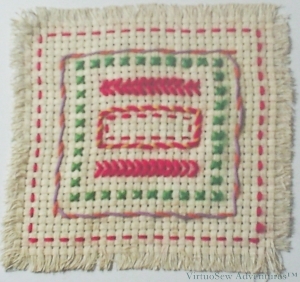
First Stitches
A little while ago, Yvette at White Threads blog interviewed me for her blog. In the interview, we talked about how I started to embroider, and I described – and provided a picture of – a piece that I worked on with Grandmama when I was about eight or nine.
I went to visit my parents a few days ago and they fished this mat out of the archives. I made it at school, when I was about six – you can tell my family has a bit of a thing about making things, from the fact it was still in existence.
I remember almost nothing about making it, except that I got bored of running stitch very quickly, and I must have mentioned that to Grandmama; maybe she suggested the arrowhead stitches and the whipped running stitch. I am fairly sure that I was the only one in the class who did anything but running stitch in a square. Embroidery wasn’t fashionable at the time, so I suspect most of the other children’s parents and grandparents wouldn’t have taken much interest in what we were doing.
The back looks hair-raising – Miss Hunter would have had a fit! – but how many of us have our very first piece of stitching to bring us back to earth?
Anyone?
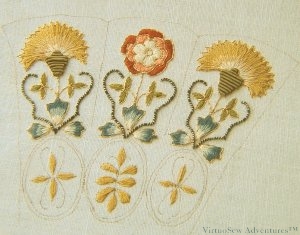
Month Three Finished
So, making progress here. All the silkwork is outlined in Elizabethan Twist, carefully following the suggested paths so as to have the smallest possible number of ends to sink.
Then the calyxs of the two carnations are covered with Olive smooth purl, cut to size and treated like a bead. This was fairly tricky because it was easy for the end of the purl (which is a very fine wire, coiled up) to catch on the silk thread being used to sew it down. In fact for the second calyx, I waxed the thread, which made the whole experience less fraught! I notice I didn’t quite get all the lengths or maybe spacings right for the first calyx, but for now I shall leave it as it stands.
Then I couched the striped thread curlicues. Again it was tricky to place the black couching thread where it would disappear into the thread being couched, but I think a few tweaks with a needle will fix that!
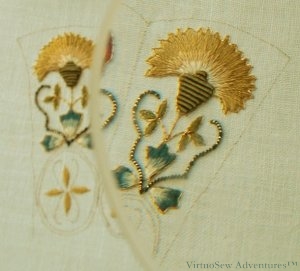
Through A Glass Clearly
Finally, I thought I would show what a difference a magnifier makes. As I think I have said before, it is the change in size that terrifies. I began by stitching without a magnifier and was reasonably happy doing so. I just felt that it would be a useful additional tool, especially given some of the other projects I have in mind.
My eyes become accustomed to regarding the magnified view as normal, then when I stop for a cup of tea, I push the magnifier to one side to have a “proper” view. At which point there’s a small squawk and my husband asks what’s wrong. “It’s gone all tiny”, I say, “Don’t tell me I stitched that!”. After the said cup of tea, ordinary views reassert themselves and it doesn’t seem quite so astonishing.
Which is really just as well. We don’t embroider to scare ourselves, after all!
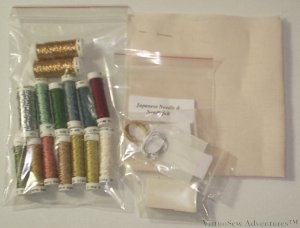
Tudor And Stuart Goldwork Kit
I decided to follow another Thistle Threads Online University course. This time it is the Tudor and Stuart Gold Master Class, and my first materials kit arrived today. There is more of that lovely Au Ver A Soie, and a lot of gold thread for practising with, as well as for working on the spot sampler.
The real attraction of this course to me is that Tricia has worked out how some of the ornate and now mysterious stitches of the period would have been worked. The stitches shown on the video look fascinating, and as well as providing instructions, she is providing animations to help her students learn how to work them. First, however, there is the silkwork to do, largely in Queen Stitch, Rice Stitch (a cross stitch variation), and Roman Stitch.
As with the Floral Glove Needlecase, there was a larger number of students enrolling than Tricia expected, and between us we appear to have wiped out the worldwide stocks of some colours in the silk thread. As with all specialist enterprises, the manufacturers tend to expect small orders, and it may take years for a dye lot to be used up. However, we can hope that more people will be introduced to these threads and will begin to use them more. Potentially this will lead to more shops stocking the more unusual materials, and make it easier for us to buy them.
As Shakespeare would have said, “A consummation devoutly to be wished!”
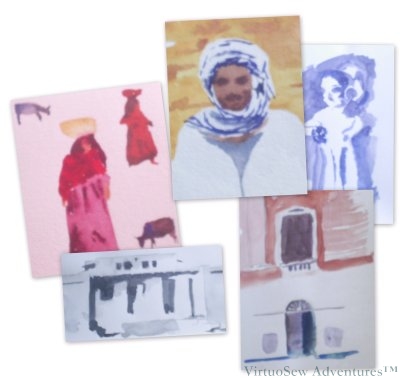
Collage of painted sketches for the Dreams of Amarna project
I’m still trying to think about and plan what to include, so I have been taking some of the photographs, and trying to produce paintings or drawings based on them.
This is serving a twofold purpose, as I have been developing my understanding of techniques, as well as learning how to distil the detail in the photographs. If it is important to simplify the sources in painting, it is more important in embroidery, where the effects created through stitch choice, thread choice, or the decision to raise the surface with padding also contribute to the final result.
The paintings aren’t particularly good, but that really isn’t the point of them, so I don’t mind. They aren’t finished pieces – I simply want to force myself to look at the photographic sources with an analytical eye. I hope then that it will come more naturally each time I find a bit I want to work on and embroider.
In fact as I look at this collage of paintings, I’m quite pleased. At least I have shown an appreciation of where the darks and the lights need to be, and those are what make a picture easy to understand.
I know that an embroidery which is “about” ancient Egypt – even if only indirectly – will have to include some gold and silver – not least, that same Crock of Gold hoard that caused so much consternation to the excavators when it was found (artefacts have a fairly limited and specialised market, while gold bars are much easier to sell, so there was some concern about security that would never have troubled the dig under ordinary circumstances).
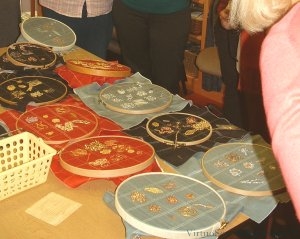
All our own work!
So the next step was a trip to Durham, for a two day course in Modern Goldwork, given by Tracy Franklin. I had a fascinating time. Tracy is an excellent teacher, and it was a real treat to be able to concentrate on learning something entirely new to me. The class had the bonus that Tracy had plenty of goldwork materials available for purchase, and my local embroidery shops don’t have any. Some of what I bought for my coursework was in fact for “Dreams of Amarna” instead!
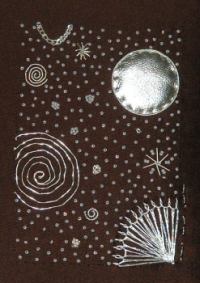
"Starbright", completed November 2008
When I returned, I worked a small panel as an attempt to consolidate my grasp on the techniques and the materials. I even included some padded silver kid leather, and the background is starred with beads.
I’m quite pleased with the panel, as I managed to use almost every technique we were taught. The base fabric was a tightly woven brown synthetic, which was rather trying to work with, but I wanted something very firm for this first solo attempt at goldwork.
I will need to use very different fabrics for Amarna, and I expect that trial and error will be much employed!
You might be able to see a line of stitching, running up the edge. That’s my “signature,” in Morse code. It’s much easier to do small and neatly than letters, and sometimes I manage to hide the signature in the design.
When I am creating an embroidered piece for someone else, I try to make sure that I also provide something about the design and the making of the work. Not just care instructions, but a description of the design choices and why I made them, or if I was working to a brief, a description of the influence of the brief on my approach to the work. Given my interest in history and archaeology, it’s perhaps not surprising that the idea of providing Something For The Archive rather appeals to me.
And on that score, and on behalf of those in the future who will be interested in embroidery – please, sign your work, date it, write about it. Just think how thrilled we always are to gain an insight into the work of designers and artisans of the past!

The Rose Outlined
The embroidery on the Floral Glove Needlecase is based around the tabbed cuffs of gloves which were often presented as gifts during the Elizabethan era. We’re only doing one side of one cuff, of course, but the additional historical material we get each month, with high-resolution pictures of some of the original gloves which remain in existence, give us a very fair idea of what Thistle Threads were aiming for!
There are several useful diagrams in the instructions showing where to start and end the gold thread, which is couched down with silk. Furthermore – brave lady indeed! – Tricia has even provided us with a view of the back of the embroidery. Miss Hunter would have looked at the back to check that it met her high standards – as students we are studying that photograph to try to garner more clues to how the work fits together. It gives a better idea of stitch lengths, for instance, because the eye isn’t dazzled by the goldwork and can study the couching.
It is very detailed, rather tiring work, so even with a good light (by the way – bright sunlight is not, in this context, a good light – it bounces off the gold thread and the magnifier and tires the eyes even more quickly) and a magnifier, I can’t do much at once. What you see here is two or three sessions’ work.
I’m pleased, though. There are several new techniques and materials still to try in this month’s session, and I think I am learning a great deal – not least, working at this scale turns out to be less hair-raising than I feared!
My second post meeting the obligations of the Beautiful Blogger award – here are Seven Things About Me.
I bellydance for fun – Yes, really. I did ballet as a child, ballroom dancing as a student and now I’ve taken up bellydancing. It keeps my spine supple and gives me a weekly chance to dance – what could be better?
I lived in Paris for nearly a year – Now you know why Paris Breakfasts strikes such a chord with me! And in Paris, by the way, I danced Rock’n’Roll, which was astonishingly popular. Nightclubs had “rock’n’roll nights” where nothing else was played at all, and the standard of some of the dancing was really astonishing!
I read as much as I embroider – Possibly more. This might not be a great surprise since so much of the embroidery that I am blogging about has a vaguely literary background. My tastes range from biographies (a good Christmas present a couple of years ago was a very academic book about John of Gaunt!) and similarly factual stuff to fiction of pretty much all sorts (Tolkien to Georgette Heyer, via Margery Allingham and Terry Pratchett), except horror stories. I see no good reason for giving myself nightmares…
I used to play the violin – Not very well, but I got a lot of fun out of playing in orchestras. Frequently, something heard on the radio will result in a pause, head a-tilt and a thoughtful “I’m sure I played that in Youth Orchestra”. Fortunately my husband has chosen to find this amusing. My musical tastes run from medieval up to the present day, although I can’t get to grips with Wagner, and I get very picky after about 1860!
This I Know – when I was a teenager I found this saying of Dame Julian of Norwich in my studies of T.S. Elliot :
“Our dearworthy Lord said not thou shalt not be tempested, thou shalt not be travailed, but thou shalt not be overcome”.
It is much less immediately appealing than “All shall be well, and all manner of thing shall be well”, but I have clung to it in bad times and found, indeed, that I have not been overcome. Don’t underestimate the uses of perseverance!
I have very long chestnut hair – length subject to radical change without notice!
I draw and paint in watercolours – not very well, but my husband insists that I tell you that I do better than I think I do (if you follow me..)

Janice at Postcards from Wildwood has passed a Beautiful Blogger award on to me. It never occurred to me that I might get an award at all, still less one so early in my blogging career, still less passed on by a blogger I admire so much. Thank you, Janice, for your encouragement and support when I was still thinking about this project, and your further encouragement and recognition now it is actually underway.
So, here are the rules as Janice passed them on to me:
- Thank the person who gave you the award. (Thank you again, Janice!)
- Pass this award along to 15 bloggers you’ve recently discovered and whom you think are fantastic! (Maybe not fifteen, and these aren’t all recent discoveries, but they are all bloggers whose blogs I enjoy visiting)
- Contact the bloggers you’ve picked and let them know about the award.
- Share seven things about yourself (I’ll do this in a separate post).
Now, like Janice, I don’t expect or demand that you display the award or pass
it on. I’m simply taking this opportunity to say thank you for the hours of enjoyment and inspiration you have given me…
Quirky Quest with Lady Fi – I went for the pictures – wonderful, sundrenched winter photos of the countryside and frolicking animals. I’ve stayed because of her use of the English language, spare and poetic, and because of the delight she manages to find in everyday events. Thank you LadyFi!
PinTangle – This is one of the first blogs I subscribed to when I started following any blogs at all. I’ve found a lot of interesting blogs from Sharon’s occasional series listing sewing, art, and embroidery blogs (she’s reached the letter S), and her band sampler posts were largely responsible for the direction I eventually took for the Autumn Leaves Skirt. Thank you Sharon B!
The Embroiderer’s Story – I can’t remember how I landed at The Embroiderer’s Story, but I was instantly fascinated by the research that was going into the reconstruction of the Margaret Laton jacket which is in the Victoria and Albert Museum. Not only research into stitching techniques, but research into the threads used and how they might be made. Then the challenges of sorting out display and maintenance of the finished piece – if you’ve ever wondered why there aren’t more reconstructions on display, this is why! Thank you Tricia!
Contemporary Embroidery – Karen’s work while I have been visiting has been primarily in white with small colour highlights, and inclusions of vintage textiles. Her subtle use of textural variations, and her beautiful photographs of gorgeously uncrumpled pieces, are a constant source of inspiration and delight. Thank you Karen!
White Threads – Yvette created The Left handed Embroiderer’s Companion, for which a good proportion of the sewing population should be singing her praises unceasingly (I’m holding out for the Right Handed Version, which is in preparation). Her posts from Ethiopia have been thought-provoking, too –
there is so much more in the world than any of us can be aware of, and it is
good to be reminded of the fact. Thank you Yvette!
Paris Breakfasts – Nothing at all to do with embroidery, but I find Carol’s blog about Paris and all things Parisian (especially patisserie and fashion!) enchanting and entertaining in almost equal measure. Merci, Carol!
As it happens my family has always had an interest both in archaeology, and in the history of art, so I started to look through our books to see whether I could find any reference material. I found a few things, but in truth, not enough to support the work I was trying to develop. That is scarcely surprising, really. The “Amarna Period” covers maybe thirty years. Ancient Egyptian civilisation lasted for several thousands of years! So I did the obvious thing – I contacted the Egypt Exploration Society, for whom Mary Chubb worked at the time of the dig, and asked whether they could help.
They could, and they did.
I spent a delightful (if wearing) afternoon in the library of the Society, and was even able to read and refer to the publications of the expedition, and then some months later received an email to tell me that the Society had been digitising its’ photographic archive and if I was interested, they would be happy to let me look through the archive for more source material.
Was I interested? Well, of course I was!
This time it was an entire morning, but then, the archive not only included the photographs of the finds and records of the excavation. There were pictures of the excavators at work, shots of the surrounding area, the felucca loaded with supplies… “Wonderful things!”, as Howard Carter said…
I know, I know – I haven’t set a stitch yet, but there’s so much to think about!
I also found an article about excavation organisation and methods, written by JDS Pendlebury (Director of the Expedition) at about this time, and a much later paper, written by another archaeologist about the Hittite amulet that was part of the “Crock of Gold” hoard that they found during the season. I won’t provide a link to those, as they are behind a paywall. The fact that I did pay for and download both articles shows just how attached to this project I have become!
I haven’t yet bought the biography of JDS Pendlebury. At the back of the book Mary describes his fate – parachuted into Crete (where he had been site Director at Knossos under Sir Arthur Evans), he coordinated the resistance to the German invasion, was wounded and captured, and then dragged from his sickbed to be executed. It saddens me every time I read it. Not just because of him, but because of the thousands of others, young and not so young, who were also cut off at the height of their powers, with so much yet to contribute to the world.
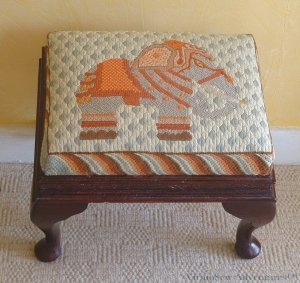
The Elephant Footstool in canvaswork
I don’t confine myself entirely to surface embroidery. I’ll give most things a try, and needlepoint is fairly high on the list of things I enjoy.
This is the second footstool I made. The first one, which I made for Grandmama, was an adaptation of a design from the Reader’s Digest Complete Guide to Needlework, but I designed this footstool for my mother after we had Grandmama’s in the house for a while, and she decided that she really liked Putting Her Feet Up Properly.
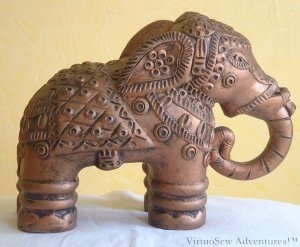
An Elephant Of No Distinction But Infinite Charm
There are several elephant ornaments in my parents’ living room, but the inspiration in this case was a glazed terracotta elephant which we call the Elephant Of No Distinction But Infinite Charm (to distinguish him from the Elephant of Considerable Distinction, who joined the family much earlier, when I was still a child!). I thought his decorated saddle cloth and harness simply cried out to be rendered in canvaswork of some description, and thought it would be fun to try.
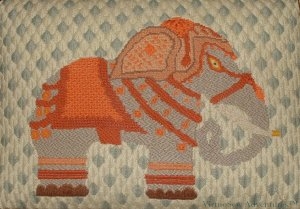
The Elephant In Canvaswork
I used two strands of Paternayan Persian wool for the whole piece. The background is worked in Leaf Stitch Filling in two shades of green. This is partly for a stylised jungle-like effect, and partly to echo the green damask fabric covering the furniture.
The reds, oranges, and browns pick up the curtain colours, and echo the Elephant Of No Distinction himself. The harness uses cashmere stitch variations, the saddle cloth is upright double cross stitch, and for some reason I can’t now recall I chose to use Byzantine stitch on the elephant’s ear.
The sides were worked with a Bargello rope pattern, but I had to fudge the final piece because I discovered the pattern wasn’t going to meet up – I hadn’t thought that far ahead when I planned it (if you can call it planning!). Almost everything I do has a slightly improvisatory element to it and in this case, I left enough space to put my mother’s name around the corner that wasn’t going to match. It almost looks deliberate!
I’m not displeased with him, but I would do something entirely different now, I think!












